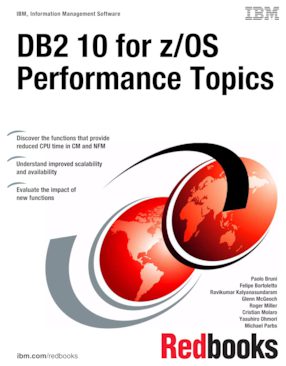About cookies on this site Our websites require some cookies to function properly (required). In addition, other cookies may be used with your consent to analyze site usage, improve the user experience and for advertising. For more information, please review your options. By visiting our website, you agree to our processing of information as described in IBM’sprivacy statement. To provide a smooth navigation, your cookie preferences will be shared across the IBM web domains listed here.

Published on 22 June 2011, updated 23 August 2013
Read in Google Books Order hardcopy
Share this page:
ISBN-10: 0738435716
ISBN-13: 9780738435718
IBM Form #: SG24-7942-00
Authors: Paolo Bruni, Felipe Bortoletto, Ravikumar Kalyanasundaram, Glenn McGeoch, Roger Miller, Cristian Molaro, Yasuhiro Ohmori and Michael Parbs
Abstract
DB2® 10 for z/OS can reduce the total DB2 CPU demand from 5-20%, compared to DB2 9, when you take advantage of all the enhancements. Many CPU reductions are built in directly to DB2, requiring no application changes. Some enhancements are implemented through normal DB2 activities through rebinding, restructuring database definitions, improving applications, and utility processing. The CPU demand reduction features have the potential to provide significant total cost of ownership savings based on the application mix and transaction types.
Improvements in optimization reduce costs by processing SQL automatically with more efficient data access paths. Improvements through a range-list index scan access method, list prefetch for IN-list, more parallelism for select and index insert processing, better work file usage, better record identifier (RID) pool overflow management, improved sequential detection, faster log I/O, access path certainty evaluation for static SQL, and improved distributed data facility (DDF) transaction flow all provide more efficiency without changes to applications. These enhancements can reduce total CPU enterprise costs because of improved efficiency in the DB2 10 for z/OS.
DB2 10 includes numerous performance enhancements for Large Objects (LOBs) that save disk space for small LOBs and that provide dramatically better performance for LOB retrieval, inserts, load, and import/export using DB2 utilities. DB210 can also more effectively REORG partitions that contain LOBs.
This IBM Redbooks® publication® provides an overview of the performance impact of DB2 10 for z/OS discussing the overall performance and possible impacts when moving from version to version. We include performance measurements that were made in the laboratory and provide some estimates.
Keep in mind that your results are likely to vary, as the conditions and work will differ.
In this book, we assume that you are somewhat familiar with DB2 10 for z/OS.
See DB2 10 for z/OS Technical Overview, SG24-7892-00, for an introduction to the new functions.
Table of Contents
Chapter 1. Introduction
Chapter 2. Subsystem
Chapter 3. Synergy with z platform
Chapter 4. Table space design options
Chapter 5. Sample workloads
Chapter 6. SQL
Chapter 7. Application enablement
Chapter 8. Distributed environment
Chapter 9. Utilities
Chapter 10. Security
Chapter 11. Installation and migration
Chapter 12. Monitoring and Extended Insight
Appendix A. Recent maintenance